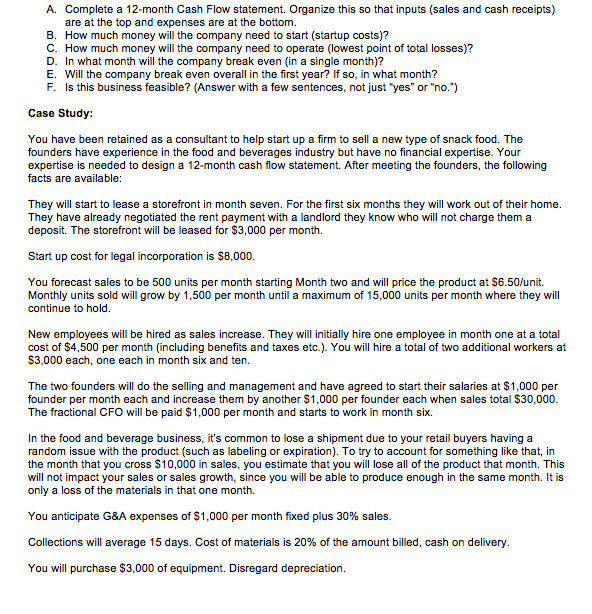
A. Complete a 12-month Cash Flow statement. Organize this so that inputs (sales and cash receipts) are at the top and expenses are at the bottom. B. How much money will the company need to start (startup costs)? C. How much money will the company need to operate (lowest point of total losses)? D. In what month will the company break even (in a single month)? E. Will the company break even overall in the first year? If so, in what month? F. Is this business feasible? (Answer with a few sentences, not just "yes" or "no.") Case Study: You have been retained as a consultant to help start up a firm to sell a new type of snack food. The founders have experience in the food and beverages industry but have no financial expertise. Your expertise is needed to design a 12-month cash flow statement. After meeting the founders, the following facts are available: They will start to lease a storefront in month seven. For the first six months they will work out of their home. They have already negotiated the rent payment with a landlord they know who will not charge them a deposit. The storefront will be leased for $3,000 per month. Start up cost for legal incorporation is $8,000. You forecast sales to be 500 units per month starting Month two and will price the product at $6.50/unit Monthly units sold will grow by 1,500 per month until a maximum of 15,000 units per month where they will continue to hold New employees will be hired as sales increase. They will initially hire one employee in month one at a total cost of $4,500 per month (including benefits and taxes etc.). You will hire a total of two additional workers at $3,000 each, one each in month six and ten. The two founders will do the selling and management and have agreed to start their salaries at $1,000 per founder per month each and increase them by another $1,000 per founder each when sales total $30,000. The fractional CFO will be paid $1,000 per month and starts to work in month six. In the food and beverage business, it's common to lose a shipment due to your retail buyers having a random issue with the product (such as labeling or expiration). To try to account for something like that, in the month that you cross $10,000 in sales, you estimate that you will lose all of the product that month. This will not impact your sales or sales growth, since you will be able to produce enough in the same month. It is only a loss of the materials in that one month. You anticipate G&A expenses of $1,000 per month fixed plus 30% sales. Collections will average 15 days. Cost of materials is 20% of the amount billed, cash on delivery. You will purchase $3,000 of equipment. Disregard depreciation. A. Complete a 12-month Cash Flow statement. Organize this so that inputs (sales and cash receipts) are at the top and expenses are at the bottom. B. How much money will the company need to start (startup costs)? C. How much money will the company need to operate (lowest point of total losses)? D. In what month will the company break even (in a single month)? E. Will the company break even overall in the first year? If so, in what month? F. Is this business feasible? (Answer with a few sentences, not just "yes" or "no.") Case Study: You have been retained as a consultant to help start up a firm to sell a new type of snack food. The founders have experience in the food and beverages industry but have no financial expertise. Your expertise is needed to design a 12-month cash flow statement. After meeting the founders, the following facts are available: They will start to lease a storefront in month seven. For the first six months they will work out of their home. They have already negotiated the rent payment with a landlord they know who will not charge them a deposit. The storefront will be leased for $3,000 per month. Start up cost for legal incorporation is $8,000. You forecast sales to be 500 units per month starting Month two and will price the product at $6.50/unit Monthly units sold will grow by 1,500 per month until a maximum of 15,000 units per month where they will continue to hold New employees will be hired as sales increase. They will initially hire one employee in month one at a total cost of $4,500 per month (including benefits and taxes etc.). You will hire a total of two additional workers at $3,000 each, one each in month six and ten. The two founders will do the selling and management and have agreed to start their salaries at $1,000 per founder per month each and increase them by another $1,000 per founder each when sales total $30,000. The fractional CFO will be paid $1,000 per month and starts to work in month six. In the food and beverage business, it's common to lose a shipment due to your retail buyers having a random issue with the product (such as labeling or expiration). To try to account for something like that, in the month that you cross $10,000 in sales, you estimate that you will lose all of the product that month. This will not impact your sales or sales growth, since you will be able to produce enough in the same month. It is only a loss of the materials in that one month. You anticipate G&A expenses of $1,000 per month fixed plus 30% sales. Collections will average 15 days. Cost of materials is 20% of the amount billed, cash on delivery. You will purchase $3,000 of equipment. Disregard depreciation







